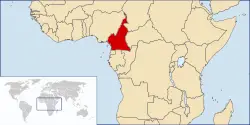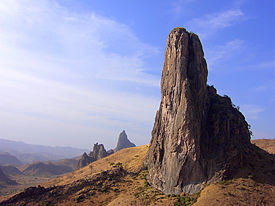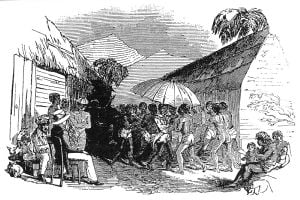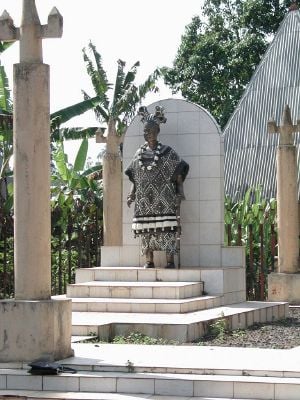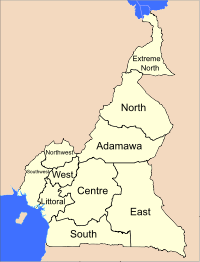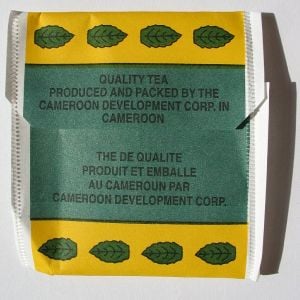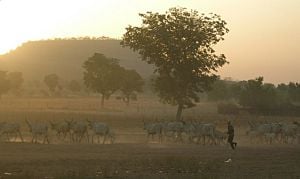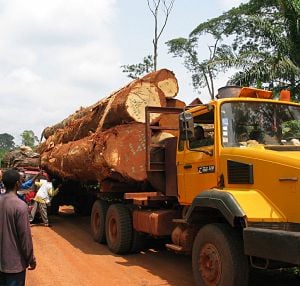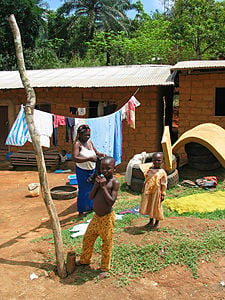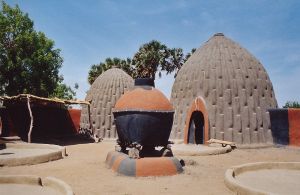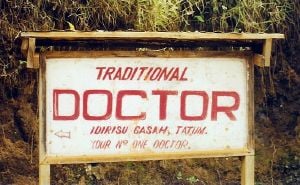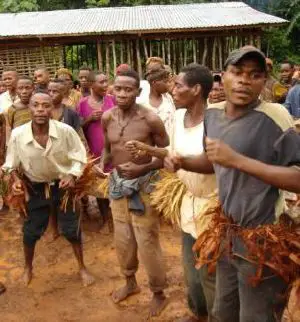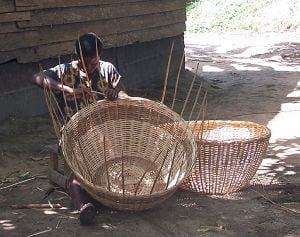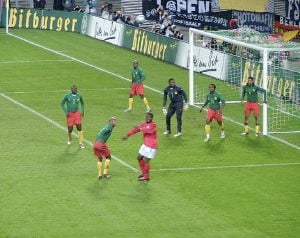Cameroon
| République du Cameroun Republic of Cameroon |
||||||
|---|---|---|---|---|---|---|
|
||||||
| Motto:¬†"Paix ‚Äď Travail ‚Äď Patrie"¬†(French) "Peace ‚Äď Work ‚Äď Fatherland" |
||||||
| Anthem:¬†√Ē Cameroun, Berceau de nos Anc√™tres¬†(French) O Cameroon, Cradle of our Forefathers¬†1 |
||||||
| Capital | Yaoundé[1] | |||||
| Largest city | Douala[1] | |||||
| Official languages | French English |
|||||
| Demonym | Cameroonian | |||||
| Government | Republic | |||||
|  -  | President | Paul Biya[1] | ||||
|  -  | Prime Minister | Philémon Yang | ||||
| Independence | from France  | |||||
|  -  | Declared | 1 January 1960  | ||||
|  -  | Annexation of former British Cameroon | 1 October 1961  | ||||
| Area | ||||||
|  -  | Total | 475,442 km² (54th) 183,568 sq mi  |
||||
|  -  | Water (%) | 1.3 | ||||
| Population | ||||||
|  -  | July 2009 estimate | 19,100,000 (58th) | ||||
|  -  | 2003 census | 15,746,179  | ||||
|  -  | Density | 39.7/km² (167th) 102,8/sq mi |
||||
| GDP (PPP) | 2010 estimate | |||||
|  -  | Total | $44.327 billion[2]  | ||||
|  -  | Per capita | $2,170[2]  | ||||
| GDP (nominal) | 2010 estimate | |||||
|  -  | Total | $22.478 billion[2]  | ||||
|  -  | Per capita | $1,100[2]  | ||||
| Gini (2001) | 44.6[3] (medium)  | |||||
| Currency | Central African CFA franc (XAF) |
|||||
| Time zone | WAT (UTC+1) | |||||
|  -  | Summer (DST) | not observed (UTC+1) | ||||
| Internet TLD | .cm | |||||
| Calling code | +237 | |||||
| 1 | These are the titles as given in the Constitution of the Republic of Cameroon, Article X. The French version of the song is sometimes called "Chant de Ralliement", as in National Anthems of the World, and the English version "O Cameroon, Cradle of Our Forefathers", as in DeLancey and DeLancey 61. | |||||
The Republic of Cameroon is a "hinge" state bridging central and western Africa. It is triangular in shape, bordered by the Atlantic Ocean to the southwest, Gabon and Equatorial Guinea to the south, Democratic Republic of the Congo to the southeast, the Central African Republic to the east, Chad to the northeast, and Nigeria to the northwest. Its capital is Yaoundé.
Cameroon is home to over 250 ethnic and linguistic groups, with the cultures of both the central and western regions mingling. Though there are tensions between them, a strong central government dominated by a single party maintains political and social stability. This has permitted the development of agriculture, roads, railways, and large petroleum and timber industries. Though its diverse population is among the most urban in western Africa, large numbers of Cameroonians live in poverty as subsistence farmers.
Power lies firmly in the hands of the president, Paul Biya, and his Cameroon People's Democratic Movement, and corruption is widespread. The Anglophone community has grown increasingly alienated from the government, and Anglophone politicians have called for greater decentralization and even the secession of the former British-governed territories.
Geography
Cameroon borders Nigeria to the west; Chad to the northeast; the Central African Republic to the east; and Equatorial Guinea, Gabon, and the Republic of the Congo to the south. Cameroon's coastline lies on the Bight of Biafra, part of the Gulf of Guinea and the Atlantic Ocean. It is the world's 53rd largest country, comparable in size to Papua New Guinea and somewhat larger than the U.S. state of California.
Tourist literature describes Cameroon as "Africa in miniature" because it exhibits all major climates and vegetation of the continent: Coast, desert, mountains, rainforest, and savanna. The highest point is Mount Cameroon at 13,435 ft (4,095 m). Located in the southwest, it is an active volcano. The largest cities are Douala, Yaoundé, and Garoua.
Cameroon is divided into five major geographic zones distinguished by dominant physical, climatic, and vegetative features. The coastal plain extends 10 to 90 mi(15 to 150 km) inland from the Gulf of Guinea and has an average elevation of 295 ft (90 m). Exceedingly hot and humid, with a short dry season, this belt is densely forested and includes some of the wettest places on earth. The South Cameroon Plateau rises from the coastal plain to an average elevation of 2,130 ft (650 m). Equatorial rainforest dominates this region, although its alternation between wet and dry seasons makes it is less humid than the coast.
An irregular chain of mountains, hills, and plateaus known as the Cameroon range extends from Mount Cameroon on the coast almost to Lake Chad at Cameroon's northern tip. This region has a mild climate, particularly on the Western High Plateau, although rainfall is high. Its soils are among Cameroon's most fertile, especially around Mount Cameroon. Vulcanism here created crater lakes. In 1986, explosions in one of these, Lake Nyos, belched toxic carbon dioxide and killed between 1,700 and 2,000 people.
The Southern Plateau rises northward to the grassy, rugged Adamawa Plateau. This feature stretches from the western mountain area and forms a barrier between the country's north and south. Its average elevation is 3,600¬†ft (1,100¬†m), and its temperature ranges from 72 to 77¬†¬įF (22 to 25¬†¬įC) with high rainfall. The northern lowland region extends from the edge of the Adamawa to Lake Chad with an average elevation of 980 to 1,150¬†ft (300 to 350¬†m). Its characteristic vegetation is savanna scrub and grass. This is an arid region with sparse rainfall and high median temperatures.
Cameroon has four patterns of drainage. In the south, the principal rivers are the Ntem, Nyong, Sanaga, and Wouri. These flow southwestward or westward directly into the Gulf of Guinea. The Dja and Kad√©√Į drain southeastward into the Congo River. In northern Cameroon, the B√©nou√© River runs north and west and empties into the Niger River. The Logone flows northward into Lake Chad, which Cameroon shares with three neighboring countries.
History
The territory of present-day Cameroon is believed to have been settled for some fifty thousand years. The longest continuous inhabitants are the Pygmy groups, such as the Baka, who now live in the southeastern rainforest. The Sao culture arose around Lake Chad around 500 B.C.E. and gave way to the Kanem-Bornu Empire in the 1400s C.E. Between the 1400s and 1600s, Fulani people moved east and settled in northern Cameroon, where they established lamidats, political and religious units. Meanwhile, various ethnic groups of the west and northwest established powerful kingdoms, ruled by fons or kings. In 1806, Modibo Adama led Fulani soldiers on a jihad against non-Muslim and partially Muslim peoples and established the Adamawa Emirate. Settled peoples who fled the Fulani caused a major redistribution of population.
Colonial era
Portuguese sailors reached the coast in 1472. They noted an abundance of crayfish (which they called prawns) in the Wouri River and, thus, named it Rio dos Camar√Ķes, Portuguese for "River of Prawns," the phrase from which Cameroon is derived. The Portuguese traded cloth and metal goods for ivory and slaves from their ships. That trade was taken over by the Dutch in the 1600s, and by the British in the 1700s. Before the slave trade was abolished in 1807, an estimated seven hundred Cameroonians a year were sold into slavery.
Once the British traders negotiated the right to establish posts on land, they were followed by Christian missionaries who pushed inland and built schools and churches. French and German traders also set up posts along the coast.
Under Germans, French, and British
The German Empire claimed the territory in 1884, based on a treaty signed with explorer Gustav Nachtigal. Despite resistance, the Germans pushed inland and had control of the area up to Lake Chad by 1911. They developed plantations for growing cash crops and initiated projects to improve the colony's infrastructure, relying on a harsh system of forced labor. When World War I broke out, the British and French who controlled neighboring colonies invaded Cameroon. After Germany's defeat, Kamerun became a League of Nations mandate and was split into French and British Cameroons. The French integrated the economy of French Cameroun with that of France and improved the infrastructure with capital investments, skilled workers, and continued forced labor. The British administered their territory from neighboring Nigeria.
The League of Nations mandates were converted into United Nations Trusteeships in 1946, and the question of independence became a pressing issue in French Cameroun. France outlawed the most radical political party, the Union des Populations du Cameroun (UPC), in 1955. This prompted a long guerrilla war and the assassination of the party's leader, Ruben Um Nyobé. In British Cameroons, the question was whether to reunify with French Cameroun or join Nigeria.
Independence
The Union des Populations du Cameroun (UPC) political party advocated independence, but was outlawed in the 1950s. It waged war on French and Cameroonian forces until 1971. In 1960, French Cameroun became independent as the Republic of Cameroun under President Ahmadou Ahidjo. The southern part of British Cameroons merged with it in 1961, to form the Federal Republic of Cameroon. The country was renamed the United Republic of Cameroon in 1972 and the Republic of Cameroon in 1984.
Ahidjo used the ongoing war with the UPC and fears of ethnic conflict to concentrate power in the presidency, continuing with this even after suppression of the UPC in 1971. His political party, the Cameroon National Union (CNU), became the sole legal political party in 1966.
Ahidjo pursued an economic policy of planned liberalism, prioritizing cash crops and petroleum exploitation. The government used oil money to create a national cash reserve, pay farmers, and finance major development projects; however, many initiatives failed when Ahidjo appointed unqualified allies to direct them.
Ahidjo stepped down on November 4, 1982, and left power to his constitutional successor, Paul Biya. He remained in control of the CNU and tried to run the country from behind the scenes until Biya and his allies pressured him into resigning. Biya began his administration by moving toward a more democratic government, but a failed coup d'état nudged him toward the leadership style of his predecessor. An economic crisis took effect in the mid-1980s to the late 1990s as a result of international economic conditions, drought, falling petroleum prices, and years of corruption, mismanagement, and cronyism. Cameroon turned to foreign aid, cut government spending, and privatized industries. With the reintroduction of multi-party politics in December 1990, Anglophone pressure groups called for greater autonomy, with some advocating complete secession.
Politics and government
The president has broad, unilateral powers to create policy, administer government agencies, command the armed forces, negotiate and ratify treaties, and declare a state of emergency. The president appoints government officials at all levels, from the prime minister (considered the official head of government), to the provincial governors, divisional officers, and urban council members in large cities. The president is selected by popular vote every seven years. In smaller municipalities, the public elects mayors and councilors.
Corruption is rife at all levels of government. In 1997, Cameroon established anti-corruption bureaus in 29 ministries, but only a quarter became operational, and in 2006, Transparency International ranked Cameroon as the 138th most corrupt of 163 countries. In January 2006, Biya initiated an anti-corruption drive under the direction of the National Anti-Corruption Observatory.
Cameroon's legal system is largely based on French civil law with common law influences. Although nominally independent, the judiciary falls under the authority of the executive's Ministry of Justice. The president appoints judges at all levels. The judiciary is officially divided into tribunals, the court of appeal, and the supreme court. The National Assembly elects the members of a nine-member High Court of Justice that judges high-ranking members of government in the event they are charged with high treason or harming national security.
The National Assembly makes legislation. The body consists of 180 members who are elected for five-year terms and meet three times per year. Laws are passed on a majority vote. Rarely has the assembly changed or blocked legislation proposed by the president. The 1996 constitution establishes a second house of parliament, the 100-seat Senate, but this body has never been put into practice.
The government recognizes the authority of traditional chiefs, fons, and lamibe to govern at the local level and to resolve disputes as long as such rulings do not conflict with national law.
President Paul Biya's Cameroon People's Democratic Movement (CPDM) was the only legal political party until December 1990. Numerous ethnic and regional political groups have since formed. The primary opposition is the Social Democratic Front (SDF), based largely in the Anglophone region of the country and headed by John Fru Ndi. Biya and his party have maintained control of the presidency and the National Assembly in national elections, but rivals contend that these have been unfair. Human rights organizations allege that the government suppresses the freedoms of opposition groups by preventing demonstrations, disrupting meetings, and arresting opposition leaders and journalists. The last elections were held on October 11, 2004.
Cameroon is a member of both the Commonwealth of Nations and La Francophonie. Its foreign policy closely follows that of its main ally, France. The country relies heavily on France for its defense, although military spending is high in comparison to other sectors of government. Biya has clashed with the government of Nigeria over possession of the Bakassi peninsula and with Gabon's president, El Hadj Omar Bongo, over personal rivalries. Nevertheless, civil war presents a more credible threat to national security, as tensions between Christians and Muslims and between Anglophones and Francophones remain high.
Administrative divisions
The constitution divides Cameroon into ten semi-autonomous regions, each under the administration of an elected Regional Council. In practice, Cameroon still follows the system that was in place prior to the adoption of a new constitution in 1996. The country is divided into ten provinces, each headed by a presidentially appointed governor. These leaders are charged with implementing the will of the president, reporting on the general mood and conditions of the provinces, administering the civil service, keeping the peace, and overseeing the heads of the smaller administrative units. Governors have broad powers: they may order propaganda in their area and call in the army, gendarmes, and police.
Economy
Cameroon's per-capita GDP (PPP) was estimated as US$2,421 in 2005, high for an African country. Major export markets include France, Italy, South Korea, Spain, and the United Kingdom. Cameroon is part of the Bank of Central African States and the Customs and Economic Union of Central Africa (UDEAC). Its currency is the CFA franc. Red tape, high taxes, and endemic corruption have impeded growth of the private sector. Unemployment was estimated at 30 percent in 2001, and about 48 percent of the population was living below the poverty threshold in 2000. Since 1997, Cameroon has been following programs advocated by the International Monetary Fund (IMF) to reduce poverty, privatize industries, and increase economic growth. Tourism is a growing sector, particularly in the coastal area, around Mount Cameroon, and in the north.
Natural resources
Cameroon's natural resources are better suited to agriculture and forestry than to industry. An estimated 70 percent of the population farms, and agriculture comprised an estimated 45.2 percent of GDP in 2006. Most agriculture is done at the subsistence scale by local farmers using simple tools. They sell their surplus produce, and some maintain separate fields for commercial use. Urban centers are particularly reliant on peasant agriculture for their foodstuffs. Soils and climate on the coast encourage extensive commercial cultivation of bananas, cocoa, oil palms, rubber, and tea. Inland on the Southern Plateau, cash crops include coffee, sugar, and tobacco. Coffee is a major cash crop in the western highlands, and in the north, natural conditions favor crops such as cotton, groundnuts, and rice. Reliance on agricultural exports makes Cameroon vulnerable to shifts in their prices.
Livestock are raised throughout the country. Fishing employs some 5,000 people and provides 20,000 tons of seafood each year. Bush meat, long a staple food for rural Cameroonians, is today a delicacy in the country's urban centers. The commercial bush meat trade has now surpassed deforestation as the main threat to wildlife in Cameroon.
The southern rainforest has vast timber reserves, estimated to cover 37 percent of Cameroon's total land area. However, large areas of the forest are difficult to reach. Logging, largely handled by foreign-owned firms, provides the government US$60 million a year, and laws mandate the safe and sustainable exploitation of timber. Nevertheless, in practice, the industry is one of the least regulated in Cameroon.
Factory-based industry accounted for an estimated 16.1 percent of GDP in 2006. More than 75 percent of Cameroon's industrial strength is located in Douala and Bonabéri. Cameroon possesses substantial mineral resources, but these are not extensively mined. Petroleum exploitation has fallen since 1985, but this is still a substantial sector such that dips in prices have a strong effect on the economy. Rapids and waterfalls obstruct the southern rivers, but these sites offer opportunities for hydroelectric development and supply most of Cameroon's energy. The Sanaga River powers the largest hydroelectric station, located at Edéa. The rest of Cameroon's energy comes from oil-powered thermal engines. Much of the country remains without reliable power supplies.
Transportation
Transport in Cameroon is often difficult. Roads are poorly maintained and subject to inclement weather, since only 10 percent are tarred. Roadblocks often serve little other purpose than to allow police and gendarmes to collect bribes from travelers. Rail service runs from Kumba in the west to Bélabo in the east and north to Ngaoundéré. International airports are located in Douala and Garoua with a smaller facility at Yaoundé. The Wouri River estuary provides a harbor for Douala, the country's principal seaport. In the north, the Bénoué River is seasonally navigable from Garoua across into Nigeria.
Media
Although press freedoms have improved since the early 2000s, the press is corrupt and beholden to special interests and political groups. Newspapers routinely self-censor to avoid government reprisals. The major radio and television stations are state-run, and other communications, such as land-based telephones and telegraphs, are largely under government control. However, cell phone networks and Internet providers have increased dramatically since the early 2000s and are largely unregulated.
Demographics
2005 estimates place Cameroon's population at 17,795,000, an estimated 41.2 percent of whom are under 15. The life expectancy is 51.16 years (50.98 years for males and 51.34 years for females).
Cameroon's population is almost evenly divided between urban and rural dwellers. Population density is highest in the large urban centers, the western highlands, and the northeastern plain. In contrast, the Adamawa Plateau, southeastern Bénoué depression, and most of the South Cameroon Plateau are sparsely populated. People from the overpopulated western highlands and the underdeveloped north are moving to the coastal plantation zone and urban centers for employment. Smaller movements are occurring as workers seek employment in lumber mills and plantations in the south and east. Although the national sex ratio is relatively even, these out-migrants are primarily males, which leads to unbalanced ratios in some regions.
Both monogamous and polygamous marriages are practiced, and the average Cameroonian family is large and extended. In the north, women tend to the home, and men herd cattle or work as farmers. In the south, women grow the family's food, and men provide meat and grow cash crops. Cameroonian society is male-dominated, and violence and discrimination against women is common.
Ethnic groups
Estimates identify anywhere from 230 to 282 different ethnic and linguistic groups in Cameroon. The Adamawa Plateau broadly bisects these into northern and southern divisions. The northern peoples are Sudanese ethnic groups, who live in the central highlands and the northern lowlands, and the Fulani, who are spread throughout northern Cameroon. A small number of Shuwa Arabs live near Lake Chad. Southern Cameroon is inhabited by speakers of Bantu and semi-Bantu languages. Bantu-speaking groups inhabit the coastal and equatorial zones, while speakers of semi-Bantu languages live in the western grasslands. Some 5,000 Pygmies roam the southeastern and coastal rainforests or live in small, roadside settlements. War in the Central African Republic has driven more than twenty thousand refugees to Cameroon's Adamawa and East provinces since 2002. Nigerians, especially Igbo, make up the largest group of foreign nationals.
Religion
Cameroon has a high level of religious freedom and diversity. The northern peoples are predominantly Muslim, although some ethnic groups retain native animist beliefs and are called Kirdi ("pagan") by the Fulani. Southern ethnic groups predominantly follow Christian or animist beliefs, or a syncretic combination of the two. People widely believe in witchcraft, and the government outlaws such practices. Suspected witches are often subject to mob violence.
Languages
The European languages introduced during colonialism have created a linguistic divide between the English-speaking fifth of the population who live in the western provinces and the French-speaking remainder of the country. Both English and French are official languages. Cameroonian Pidgin English is the most common lingua franca, especially in the formerly British-administered territories. A mixture of English, French, and Pidgin called Camfranglais has been gaining popularity in urban centers since the mid-1970s.
Education
Most children have access to free, state-run schools or subsidized, private, and religious facilities. The educational system is a mixture of British and French precedents, with most instruction in English or French. Cameroon has one of the highest school attendance rates in Africa. Girls attend school less regularly than boys do because of cultural attitudes, domestic duties, early marriage and pregnancy, and sexual harassment. Although attendance rates are higher in the south, a disproportionate number of teachers are stationed there, leaving northern schools chronically understaffed.
Health
The quality of health care is generally low. Outside the major cities, facilities are often dirty and poorly equipped. Endemic diseases include dengue fever, philariasis, leishmaniasis, malaria, meningitis, schistosomiasis, and sleeping sickness. The HIV/AIDS rate is estimated at 5.4 percent for those aged 15‚Äď49, although a strong stigma against the illness keeps the number of reported cases artificially low. Traditional healers remain a popular alternative to Western medicine.
Culture
The country is well known for its native styles of music, particularly makossa and bikutsi, and for its successful national football team.
Each of Cameroon's ethnic groups has its own unique cultural forms. Typical celebrations include births, deaths, plantings, harvests, and religious rituals. Seven national holidays are observed throughout the year, and movable holidays include the Christian and the Muslim holy days.
Music and dance are an integral part of Cameroonian ceremonies, festivals, social gatherings, and storytelling. Traditional dances are highly choreographed and separate men and women or forbid participation by one sex altogether. The goals of dances range from pure entertainment to religious devotion. Traditionally, music is transmitted orally. In a typical performance, a chorus of singers echoes a soloist. Musical accompaniment may be as simple as clapping hands and stomping feet, but traditional instruments include bells worn by dancers, clappers, drums and talking drums, flutes, horns, rattles, scrapers, stringed instruments, whistles, and xylophones; the exact combination varies with ethnic group and region. Some performers sing complete songs by themselves, accompanied by a harplike instrument.
Popular music styles include ambasse bey of the coast, assiko of the Bassa, mangambeu of the Bangangte, and tsamassi of the Bamileke. Nigerian music has influenced Anglophone Cameroonian performers, and Prince Nico Mbarga's highlife hit "Sweet Mother" is the top-selling African record in history. The two most popular styles are makossa and bikutsi. Makossa developed in Douala and mixes folk music, high life, soul, and Congo music. Performers such as Manu Dibango, Francis Bebey, Moni Bilé, and Petit-Pays popularized the style worldwide in the 1970s and 1980s. Bikutsi originated as war music among the Ewondo. Artists such as Anne-Marie Nzié developed it into a popular dance music beginning in the 1940s, and performers such as Mama Ohandja and Les Têtes Brulées popularized it internationally during the 1960s, 1970s, and 1980s.
Cuisine
Cuisine varies by region, but a large, one-course, evening meal is common throughout the country. A typical dish is based on cocoyams, maize, manioc, millet, plantains, potatoes, rice, or yams, often pounded into dough-like fufu. This is served with a sauce, soup, or stew made from greens, groundnuts, palm oil, or other ingredients. Meat and fish are popular but expensive additions. Dishes are often quite hot, spiced with salt, red pepper, and Maggi. Water, palm wine, and millet beer are the traditional mealtime drinks, although beer, soda, and wine have gained popularity. Silverware is common, but food is traditionally manipulated with the right hand. Breakfast consists of leftovers or bread and fruit with coffee or tea. Snacks are popular, especially in larger towns where they may be bought from street vendors.
Crafts
Traditional arts and crafts are practiced throughout the country for commercial, decorative, and religious purposes. Woodcarvings (particularly of masks) and sculptures are especially common. The high-quality clay of the western highlands is suitable for pottery and ceramics. Other crafts include basket weaving, bead working, brass and bronze working, calabash carving and painting, embroidery, and leather working. Traditional housing styles make use of locally available materials and vary from temporary wood-and-leaf shelters of nomadic Mbororo to the rectangular mud-and-thatch homes of southern peoples. Dwellings made from materials such as cement and tin are increasingly common.
Literature and films
Cameroonian literature and film have concentrated on both European and African themes. Colonial-era writers such as Louis-Marie Pouka and Sankie Maimo were educated by European missionary societies and advocated assimilation into European culture as the means to bring Cameroon into the modern world. After World War II, writers such as Mongo Beti and Ferdinand Oyono analyzed and criticized colonialism and rejected assimilation. Shortly after independence, filmmakers such as Jean-Paul Ngassa and Thérèse Sita-Bella explored similar themes. In the 1960s, Mongo Beti and other writers explored post-colonialism, problems of African development, and the recovery of African identity. Meanwhile, in the mid-1970s, filmmakers such as Jean-Pierre Dikongué Pipa and Daniel Kamwa dealt with the conflicts between traditional and post-colonial society. Literature and films during the next two decades concentrated more on wholly Cameroonian themes.
Sports
National policy strongly advocates sport in all forms. Traditional sports include canoe racing and wrestling, and several hundred runners participate in the 40 km (24.8 mi) Mount Cameroon Race of Hope each year. Cameroon is one of the few tropical countries to have competed in the Winter Olympics. However, sport in Cameroon is dominated by football (soccer). Amateur football clubs abound, organized along ethnic lines or under corporate sponsors. The Cameroon national football team has been one of the most successful in the world since its strong showing in the 1990 FIFA World Cup. Cameroon has won four African Nations Cup titles.
Notes
- ‚ÜĎ 1.0 1.1 1.2 Cameroon. Infoplease. Retrieved January 7, 2012.
- ‚ÜĎ 2.0 2.1 2.2 2.3 Error on call to template:cite web: Parameters url and title must be specified. International Monetary Fund.
- ‚ÜĎ Error on call to template:cite web: Parameters url and title must be specified. The World Factbook. CIA.
ReferencesISBN links support NWE through referral fees
- Mbaku, John Mukum. 2005. Culture and Customs of Cameroon. Westport, Conn: Greenwood Press. ISBN 0313332312.
- DeLancey, Mark W., and H. Mbella Mokeba. 1991. Historical Dictionary of the Republic of Cameroon. African historical dictionaries, no. 48. Metuchen, N.J.: Scarecrow. ISBN 0810823705.
- Fanso, V.G. 1989. Cameroon History for Secondary Schools and Colleges. London: Macmillan. ISBN 0333471210.
- Fitzpatrick, Mary. 2002. West Africa. Melbourne, Vic: Lonely Planet. ISBN 1740592492.
- Macmillan Education Ltd. 1985. Macmillan School Atlas for Cameroon. London: Macmillan Education. ISBN 0333393546.
- Fonge, Fuabeh Paul. 1997. Modernization Without Development in Africa: Patterns of Change and Continuity in Post-Independence Cameroonian Public Service. Trenton, NJ: Africa World Press. ISBN 0865435480.
- Geschiere, Peter. 1997. The Modernity of Witchcraft: Politics and the Occult in Postcolonial Africa. Charlottesville, VA: University Press of Virginia. ISBN 0813917026.
- Gwanfogbe, Mathew. 1983. Geography of Cameroon. London: Macmillan. ISBN 0333366905.
- Hudgens, Jim, and Richard Trillo. 1999. West Africa: The Rough Guide. London: Rough Guides. ISBN 1858284686.
- Lantum, Daniel M., and Martin Ekeke Monono. 2005. "Republic of Cameroon," Who Global Atlas of Traditional, Complementary and Alternative Medicine. World Health Organization.
- MacDonald, Brian. 1997. Military Spending in Developing Countries: How Much is Too Much? Ottawa: Carleton University Press. ISBN 0886293146.
- Neba, Aaron S., and Aaron S. Neba. 1987. Modern Geography of the Republic of Cameroon. Camden, N.J.: Neba Publishers. ISBN 0941815013.
- Nkolo, Jean-Victor, and Graeme Ewens. 2000. "Cameroon: Music of a Small Continent," World Music, Volume 1: Africa, Europe and the Middle East. London: Rough Guides Ltd.
- Swarovski Orchestra. 2004. National Anthems of The World. Koch Entertainment Dist, Llc. ISBN 9786308580987.
- West, Ben. 2004. Cameroon: The Bradt Travel Guide. Chalfont St. Peter: Bradt Travel Guides. ISBN 1841620785.
- Wight, Susannah. 2006. Cameroon. Spain: MTH Multimedia S.L.
External links
All links retrieved November 25, 2023.
- U.S. Department of State. U.S. Relations With Cameroon.
- UNAids. Cameroon.
- ReliefWeb. Cameroon: Population Movement; DREF Bulletin no. MDRCM004.
- British Broadcasting Corporation. February 20, 2007. New language for divided Cameroon.
- Sa'ah, Randy Joe. June 23, 2006. Cameroon girls battle 'breast ironing'. British Broadcasting Corporation.
- Reading women writers and African literatures. Cameroon Literature at a glance.
Credits
New World Encyclopedia writers and editors rewrote and completed the Wikipedia article in accordance with New World Encyclopedia standards. This article abides by terms of the Creative Commons CC-by-sa 3.0 License (CC-by-sa), which may be used and disseminated with proper attribution. Credit is due under the terms of this license that can reference both the New World Encyclopedia contributors and the selfless volunteer contributors of the Wikimedia Foundation. To cite this article click here for a list of acceptable citing formats.The history of earlier contributions by wikipedians is accessible to researchers here:
The history of this article since it was imported to New World Encyclopedia:
Note: Some restrictions may apply to use of individual images which are separately licensed.


